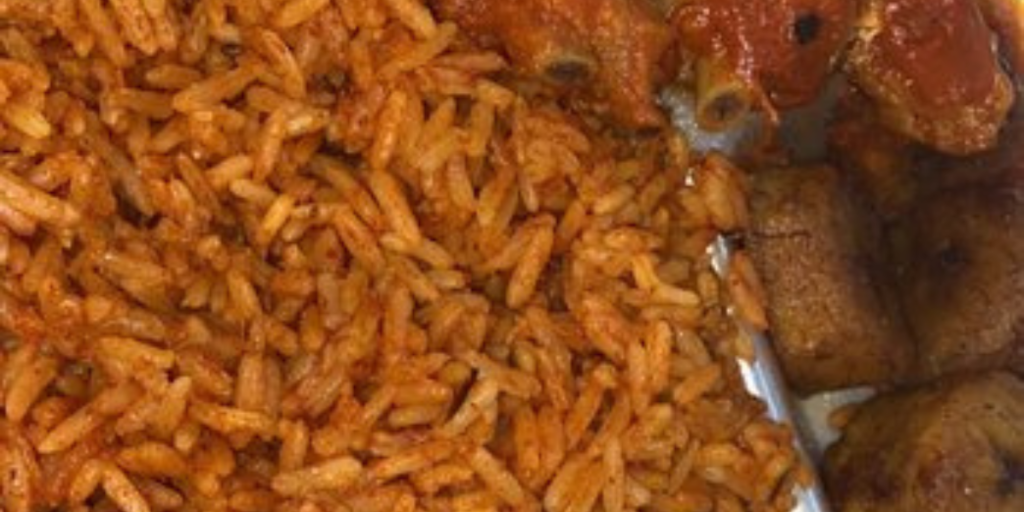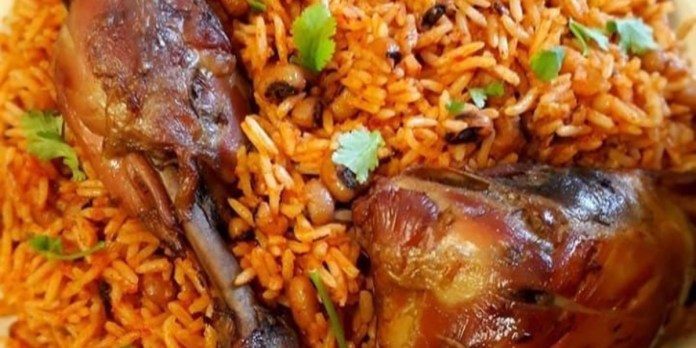Table of Contents
Jollof rice is not just a dish; it’s a celebration of West African culture and flavors. Known for its bright reddish-orange color, rich tomato base, and deeply flavorful taste, Jollof rice is a staple in many West African countries, including Nigeria, Ghana, Senegal, Liberia, and Sierra Leone. Each country has its unique twist on the dish, but the essential elements remain the same: rice cooked in a flavorful tomato-based sauce. This Jollof rice recipe will guide you through five easy steps to make the perfect Jollof rice, whether you’re a beginner in the kitchen or a seasoned cook.
Step 1: Preparing the Ingredients for Jollof Rice

Before you start cooking, it’s crucial to gather all the ingredients. The quality of your ingredients significantly impacts the final flavor of your Jollof rice. Here’s what you’ll need:
Basic Ingredients:
- 2 cups long-grain parboiled rice: This type of rice is preferred for Jollof because it absorbs the sauce well without becoming mushy.
- 4 large tomatoes, chopped: Fresh tomatoes add a natural sweetness and balance to the dish.
- 1/2 cup tomato paste: Enhances the tomato flavor and gives the Jollof rice its distinctive color.
- 2 red bell peppers: Adds sweetness and depth to the tomato base.
- 1 Scotch bonnet or habanero pepper: Provides the signature heat and spiciness associated with Jollof rice.
- 1 large onion: Divided into two parts; one half for the sauce, and the other half for seasoning the rice.
- 3-4 cups chicken or vegetable stock: Adds richness to the dish.
- 1/4 cup vegetable oil: For sautéing.
- 2-3 cloves garlic, minced: Adds aroma and depth to the sauce.
- 1 teaspoon ginger, minced: Optional but recommended for extra flavor.
- Salt and pepper to taste.
Additional Seasonings:
- 1 teaspoon thyme: Adds an earthy, aromatic touch.
- 1 teaspoon curry powder: Common in Nigerian Jollof rice for a slightly spiced flavor.
- 2 bay leaves: Enhances the overall depth of the dish.
- 1 tablespoon bouillon powder or stock cubes: Intensifies the flavor, making the dish more savory.
Ingredient Preparation Tips:
- Wash the rice thoroughly: Rinse the rice under cold water to remove excess starch. This step prevents the rice from sticking together and becoming too mushy when cooked.
- Blend the tomatoes, red bell peppers, Scotch bonnet, and half the onion: Blend until smooth. This mixture will serve as the base for your sauce. You can use a high-speed blender for a smoother consistency.
- Finely chop the remaining onion: This will be used to sauté and build the flavor of the sauce.
- Thieboudienne: Best Senegalese Jollof Rice and Fish 1
Step 2: Making the Tomato Base
The tomato base is the heart and soul of Jollof rice. Getting this step right will ensure your rice is bursting with flavor. Here’s how to make the perfect Jollof tomato base:
Sauté the Onion:
Start by heating the vegetable oil in a large pot over medium heat. Once the oil is hot, add the finely chopped onions. Sauté the onions for about 5-7 minutes, stirring occasionally, until they turn golden brown and slightly caramelized. This step helps to bring out the natural sweetness in the onions and forms a rich foundation for the sauce.
Add the Tomato Paste:
Add ½ cup of tomato paste to the pot with the onions. Stir continuously for about 5-7 minutes. Allow the tomato paste to cook thoroughly to get rid of its raw taste and to deepen its color. This caramelization process is crucial as it gives the Jollof rice its signature deep reddish color and rich flavor.
Incorporate the Blended Tomato Mixture:
Pour the blended mixture of tomatoes, red bell peppers, and Scotch bonnet into the pot. Stir well to combine with the tomato paste and onions. Reduce the heat to medium-low and let the mixture simmer for 30-40 minutes, stirring occasionally. This slow cooking helps to develop the flavors, allowing the acidity of the tomatoes to mellow out.
Season the Sauce:
Add thyme, curry powder, minced garlic, ginger, bay leaves, bouillon powder or stock cubes, and salt and pepper to taste. Adjust the seasoning as needed. Allow the sauce to simmer for another 5-10 minutes, ensuring all the flavors are well incorporated.
Step 3: Cooking the Rice in the Tomato Sauce
Once your tomato base is ready, it’s time to add the rice. This is where the magic happens, as the rice absorbs all the rich flavors from the tomato sauce, transforming into the iconic Jollof rice.
Adding the Rice:
- Pour the washed and drained rice into the pot with the simmering tomato sauce. Stir well to ensure that every grain is coated in the sauce.
- Add chicken or vegetable stock: Pour in enough stock to cover the rice completely. The amount of liquid should be about 1½ times the amount of rice. For example, if you’re using 2 cups of rice, you’ll need about 3 cups of stock. This helps to cook the rice evenly and prevents it from sticking to the pot.
Cook on Low Heat:
- Reduce the heat to low, cover the pot with a tight-fitting lid, and let the rice cook for 20-30 minutes. It’s important to keep the heat low to avoid burning the bottom while the rice cooks.
- Stir occasionally to ensure even cooking. Stirring the rice gently helps redistribute the sauce and prevents sticking.
Steam the Rice:
- If the liquid is absorbed before the rice is fully cooked, you can add a little more stock or water. Cover the pot tightly and allow the rice to steam for an additional 5-10 minutes until it’s fully cooked and fluffy.
- Fluff the rice with a fork to separate the grains and distribute the sauce evenly. The rice should be tender, with each grain distinct yet well-coated in the flavorful tomato sauce.
- Nigerian Dinner Ideas for Tonight: Best of 2024
Step 4: Adding Final Seasonings and Adjustments

Now that your Jollof rice is almost done, it’s time to add the final touches that make it stand out. This step allows you to fine-tune the flavor to suit your preferences.
Taste and Adjust Seasoning:
- Check the salt and spice levels and adjust if necessary. If you prefer your Jollof rice to be spicier, you can add more chopped Scotch bonnet pepper at this stage.
- For an extra depth of flavor, consider adding a dash of smoked paprika or cayenne pepper. This adds a smoky undertone that elevates the dish.
Add Vegetables for a Jollof Rice Twist:
To make your Jollof rice more colorful and nutritious, consider adding some mixed vegetables, such as:
- Sweet corn: Adds a touch of sweetness.
- Diced carrots and peas: Provide color and texture.
- Green beans: Introduce a slight crunch.
Stir the vegetables into the rice during the last 5-10 minutes of cooking, allowing them to steam and retain their vibrant colors.
Adding Protein:
For a complete meal, you can include protein directly in the Jollof rice. Some options include:
- Grilled chicken or beef: Sear the meat separately and mix it into the rice before the final steaming.
- Shrimp: Cooked shrimp can be added towards the end to avoid overcooking.
- Nigerian Dinner Ideas |List of Food for Dinner Best 5
Step 5: Serving and Garnishing Your Jollof
Now that your Jollof is ready, it’s time to plate it beautifully. Presentation is key, especially if you’re serving the dish for a special occasion.
Garnishing Tips:
- Top with slices of fresh bell peppers or tomatoes for added color.
- Garnish with chopped parsley or cilantro for a fresh, aromatic touch.
- Serve with fried plantains (dodo) or a side salad to complement the dish.
Pairing Suggestions:
- Fried plantains: Their sweetness balances the savory flavor of Jollof rice.
- Grilled chicken, beef, or fish: Adds a protein element to the meal.
- Coleslaw or salad: Provides a crunchy and refreshing side.
Diving Deeper into Jollof Rice Variations
While this basic Jollof recipe gives you the classic flavors, variations exist across different regions and preferences:
Nigerian Jollof Rice
- Known for its bold and spicy flavors, Nigerian Jollof rice often includes a generous amount of chili peppers and spices.
- The rice is usually cooked until it’s slightly smoky, giving it the characteristic “party Jollof” flavor that many Nigerians love.
Ghanaian Jollof Rice
- Ghanaian Jollof rice is often characterized by the use of basmati rice, which gives it a slightly different texture compared to the long-grain rice used in the Nigerian version.
- The cooking process involves a thick, tomato-based stew that deeply infuses the rice.
Senegalese Jollof (Thieboudienne)
- The Senegalese version, known as Thieboudienne, is often made with broken rice and fish, adding a unique texture and flavor.
- It includes a variety of vegetables such as carrots, sweet potatoes, and eggplants.
Liberian and Sierra Leonean Jollof
- These versions often feature palm oil for a distinctive taste and incorporate smoked fish or crab to enhance the flavor.
Historical and Cultural Background of Jollof Rice
Jollof rice is not just a dish but a cultural icon across West Africa. It is believed to have originated from the Wolof Empire (now modern-day Senegal and The Gambia), and its spread throughout the region reflects the history of trade and cultural exchange. Over the centuries, each country has adapted the recipe to suit its local ingredients and preferences, leading to the emergence of various regional versions.
The Jollof Rice Wars
The friendly rivalry over who makes the best Jollof rice is popularly known as the Jollof Rice Wars, particularly between Nigeria and Ghana. Both countries claim superiority, with each insisting that their version is the best. This competition has sparked countless debates, cook-offs, and even international food festivals celebrating Jollof rice.
Essential Tips for Making the Perfect Jollof
- Use the Right Type of Rice: Long-grain parboiled rice is ideal for Jollof because it absorbs flavors well and maintains its structure. However, basmati rice can also be used if you prefer a slightly different texture.
- Get the Tomato Base Right: Achieving the perfect balance between tomatoes, peppers, and onions is crucial. The tomato base should be rich and flavorful before adding the rice.
- Cook on Low Heat: Low heat allows the rice to cook slowly and evenly, ensuring that it absorbs all the flavors from the tomato sauce.
- Stir Occasionally but Gently: Stirring the rice helps prevent burning, but be gentle to avoid making the rice mushy.
- Don’t Rush the Process: Good Jollof rice takes time. Allow the flavors to develop and the rice to cook slowly for the best results.
Exploring Jollof Rice Variations Around the World

Jollof rice is no longer confined to West Africa; it has gained popularity across the globe, with chefs and home cooks experimenting with various twists on the classic dish.
Caribbean Jollof Rice
In the Caribbean, Jollof rice is often infused with local spices and ingredients, such as scotch bonnet peppers, thyme, and coconut milk, giving it a distinct island flair.
American Southern Jollof
In the Southern United States, some chefs incorporate smoked sausages, crawfish, or okra, blending the flavors of Jollof rice with Cajun and Creole influences.
Asian Fusion Jollof
Some modern chefs have introduced an Asian twist by adding ingredients like soy sauce, ginger, and sesame oil, creating a fusion that merges African and Asian flavors.
Frequently Asked Questions About Jollof Rice
Q: Can I make Jollof rice without tomato paste?
A: Yes, you can make Jollof rice without tomato paste. You can use a higher quantity of fresh tomatoes to achieve a similar flavor and color. However, the paste adds a richer, deeper color and taste.
Q: What’s the best rice-to-liquid ratio for Jollof rice?
A: The typical ratio is 1:1.5 or 1:2 (rice to liquid), depending on the type of rice you’re using. Long-grain parboiled rice often requires more liquid compared to basmati rice.
Q: Can Jollof rice be frozen?
A: Yes, Jollof rice can be frozen. Store it in an airtight container, and it will keep for up to 3 months. Reheat thoroughly before serving.
Q: Is Jollof rice gluten-free?
A: Yes, Jollof rice is naturally gluten-free as it primarily consists of rice, tomatoes, and vegetables. Just ensure that the stock or bouillon used is also gluten-free.
Q: How do I achieve the “party Jollof” flavor?
A: To get the smoky “party Jollof” flavor, allow the rice to cook on low heat until a slight crust forms at the bottom. This caramelized layer, known as “bottom pot” or “concon,” is highly sought after for its smoky and rich flavor.
Adding More Flavor: Optional Ingredients for Jollof Rice
To take your Jollof rice recipe up a notch, consider adding any of the following:
- Smoked fish or crayfish powder: Adds a smoky, umami-rich flavor.
- Crushed red pepper flakes: For extra heat.
- Sautéed shrimp or diced chicken: Mix in just before serving for a protein boost.
- Olives or capers: Provide a unique tanginess.
Enjoying the Perfect Plate of Jollof Rice
Making Jollof rice in five easy steps allows you to create a dish that is not only delicious but also steeped in history and culture. With its rich tomato flavor, aromatic spices, and fluffy texture, Jollof rice is more than just a meal; it’s a celebration of West African culinary excellence.
Whether you prefer the Nigerian, Ghanaian, or Senegalese style, or even a modern twist with your favorite ingredients, Jollof rice continues to bring people together, sparking joy and friendly competition across cultures.
Now that you have mastered this Jollof rice recipe, go ahead and share it with friends and family. Experiment with different variations, try it with new proteins, or even fuse it with another cuisine. Whatever you choose, Jollof rice is sure to be a hit at your dining table!




















